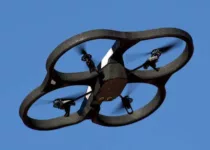Last week there were a number of incidents where commercial airplane pilots reported near misses with drones. One particularly dangerous drone event caused firefighters to ground airtanker planes during a wildfire in California. And there have been drones crashing near the White House and other public areas (most notably a drone actually landed on an outdoor stage where German Chancellor Angela Merkel was seated waiting to make a speech).
A lot of politicians have jumped on that particular bandwagon calling for stiffer punishments and laws governing drone use.
The FAA, to their credit, has been leery of drones for some time and has tried to implement rules governing their use. Some have said their rules were too strict, particularly their ban on using drones for commercial deliveries or other profit making purposes (although a local San Francisco news station has started using drones in some of their reporting and in my opinion that is a clear example of using a drone for profit – but maybe they have a Section 333 special certified pilot’s exemption).
So what can be done about idiots who buzz airports or public places or want a better view of a wildfire?
It doesn’t really matter if there are heavy fines for flying drones where they shouldn’t be flown – people are just going to do it anyway if they can.
One simple solution for some of these problems is to make it illegal to even sell a drone in the United States that weighs more than 55 pounds or can be flown beyond line of sight (the FAA’s limits). I would add another built-in restriction limiting heights to under than 300 feet.
A second, possibly more complex solution would be for drone manufacturers to implement automatic ‘no fly zone’ detection and avoidance circuitry. If the drone detects an FAA or military pre-defined signal it could not fly over that area even if the operator tries to send it there. So the White House, military installations, airports, outdoor sports venues or even entire urban areas could install beacons that transmit ‘no fly zone’ signals and drones (with the security feature built in) simply couldn’t fly anywhere near those places. Portable, temporary beacons could also be deployed at forest fire locations or when the airspace in an area needs to be cleared. You could even sell these beacons to private individuals who don’t want drones flying over their swimming pools.
Undoubtedly there would be a lot of pissed off hobbyists out there who would insist they have the right to fly their expensive toys anywhere they damn well please and I’m sure that people would try to circumvent the restricting circuitry. And of course drone manufacturers would complain about the extra costs (although once they are implemented in silicone the sensors to receive the signals would be the only extra cost). I realize there would be black market (or grey market) drones intended for sale in other countries but smuggled into the U.S. illegally and these restrictions probably wouldn’t do much to deter terrorists or drug smugglers from using drones, but they might prevent foolish hobbyists from crashing their toys into a crowd of spectators at a highschool football game or into the engine of an airplane coming in for a landing.
All drones would be required to have a certification in order to be legally sold in the U.S. If you wanted a drone that could exceed height or distance restrictions you would need a special license. We already have restrictions on all sorts of things – you can’t sell flammable or carcinogenic baby clothes or furniture, cars must have seatbelts, you can’t buy automatic weapons or explosives without special licenses, etc. – so having built-in safety features for drones shouldn’t be that onerous.








